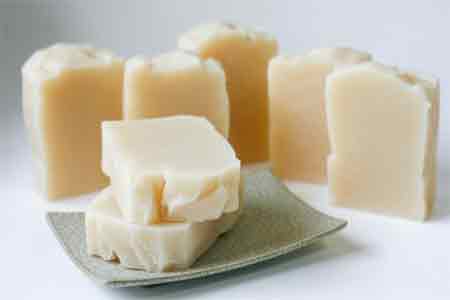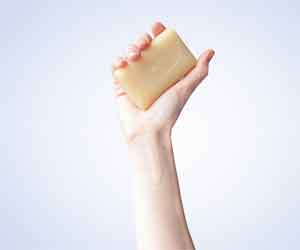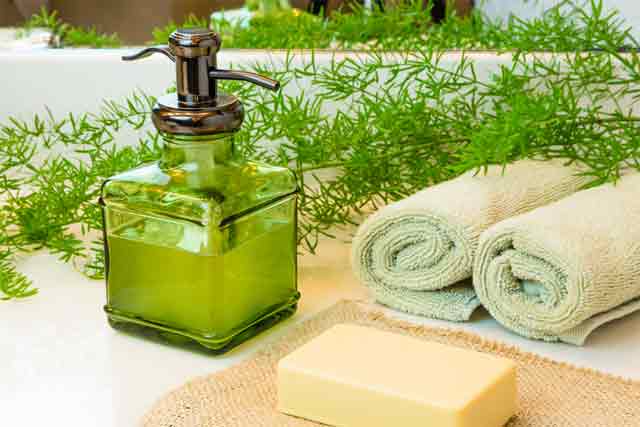Making Home Made Soap
Castile soap gets its name from the Castile region in Spain. Olive oil has been used to make natural soap in the region for centuries. In the strictest sense, the term castile soap today means soap made with olive oil, with no other fats or oils added. However, it have become common to call soap made with any and only vegetable oils and not animal fats castile soap.
The following is a set of basic instructions to make pure olive oil soap at home.

Materials Needed
All soapmaking tools should be kept separate from food preparation tools. Purchase extra bowls, graters, etc. for soapmaking.
- Kitchen scale
- Two plastic pitchers (must be labeled “dishwasher safe”)
- Soap pot
- Long handled wooden spoons
- Ladle
- Two kitchen thermometers
- Large plastic container with lid
- White butcher paper, or large needlepoint screen, or rigid plastic cutting board
- Old towel
- Sharp knife
- Rubber gloves
- Safety goggles
- 52 ounces olive oil
- 7 ounces sodium hydroxide
- 20 ounces cold water
- Additional water
Grade B olive oil makes the best soap. The finer olive oils are best for eating; the fattier, thicker olive oils make emollient soap.
Sodium hydroxide is available in hardware stores; it is also called lye.
Safety First
Lye is caustic. Before making soap, prepare your workstation by covering surfaces with old newspaper or old towels. Wear protective rubber gloves and protective eye goggles.
If lye touches skin or eyes, flush immediately with cold water. If a burn ensues, contact a physician.

Prepare Sodium Hydroxide
- Place one empty, plastic pitcher on the kitchen scale and set to 0. Carefully add 7 ounces of sodium hydroxide.
- Use the same method to add 20 ounces cold water to the second pitcher.
- Without splashing, gently pour the water into the lye. Do not pour the lye into the water.
- Stir gently until you are certain that all of the lye has dissolved.
- The lye solution will be hot; takes its temperature and it should reach 150 – 200 degrees F.
- Secure the lid and place pitcher in cold water bath (either in your sink or in a large pot.)
Prepare Oil
- Place soap pot on kitchen scale and set to 0.
- Pour 52 ounces of olive oil into soap pot.
- Set on medium heat and stir as the oil warms. Bring the oil to 100 degrees F.
Make Soap
- Check the temperature of the lye solution. When both the oil and the lye solution are at about 100 degrees F., remove oil from heat and continue.
- Gently and carefully pour the lye solution into the oil while stirring gently and constantly.
- Continue to stir the solution gently for fifteen minutes to an hour.As the soap mixture is stirred, “trailings” become visible. Trailings are the visible drops of soap on top of the mixture that take a moment to be incorporated back into the solution. Pure olive oil soap trailings can be hard to see, but if the solution has been stirred for almost an hour it is ready, even if its hard to see trailings.
- Pour the warm soap solution into the primary mold, the large plastic box container. Scrape all of the soap out of the pot and into the mold.
- Secure lid and wrap the mold in an old towel to keep it warm.
- Open the mold every 12 hours and, if there is liquid on top, stir to mix it all together again.
- When at least 48 hours have passed, and the soap has stopped separating, open the mold and let the soap continue to dry in the mold. The soap is still caustic at this point.
- Within a few days the top should seem firm and the soap should easily break away if you pull on the sides of the mold. Turn the mold over and press the bottom to release the soap. If the soap does not easily release, let it continue to cure for another day or so.
- Release the soap and store it on butcher paper, or a rigid piece of plastic, or needlepoint screen. Let the soap continue to air dry for a week.
- Slice the soap with a sharp knife into bars.
The longer the bars are exposed to the air and cured, the harder the soap bars will be (and, therefore, longer lasting.)
This recipe results in a mild soap that lathers quickly and produces small bubbles. The soap will be an off-white color. While using this soap, avoid leaving it sitting in water or it will melt. Keep it on a soap dish that drains.
